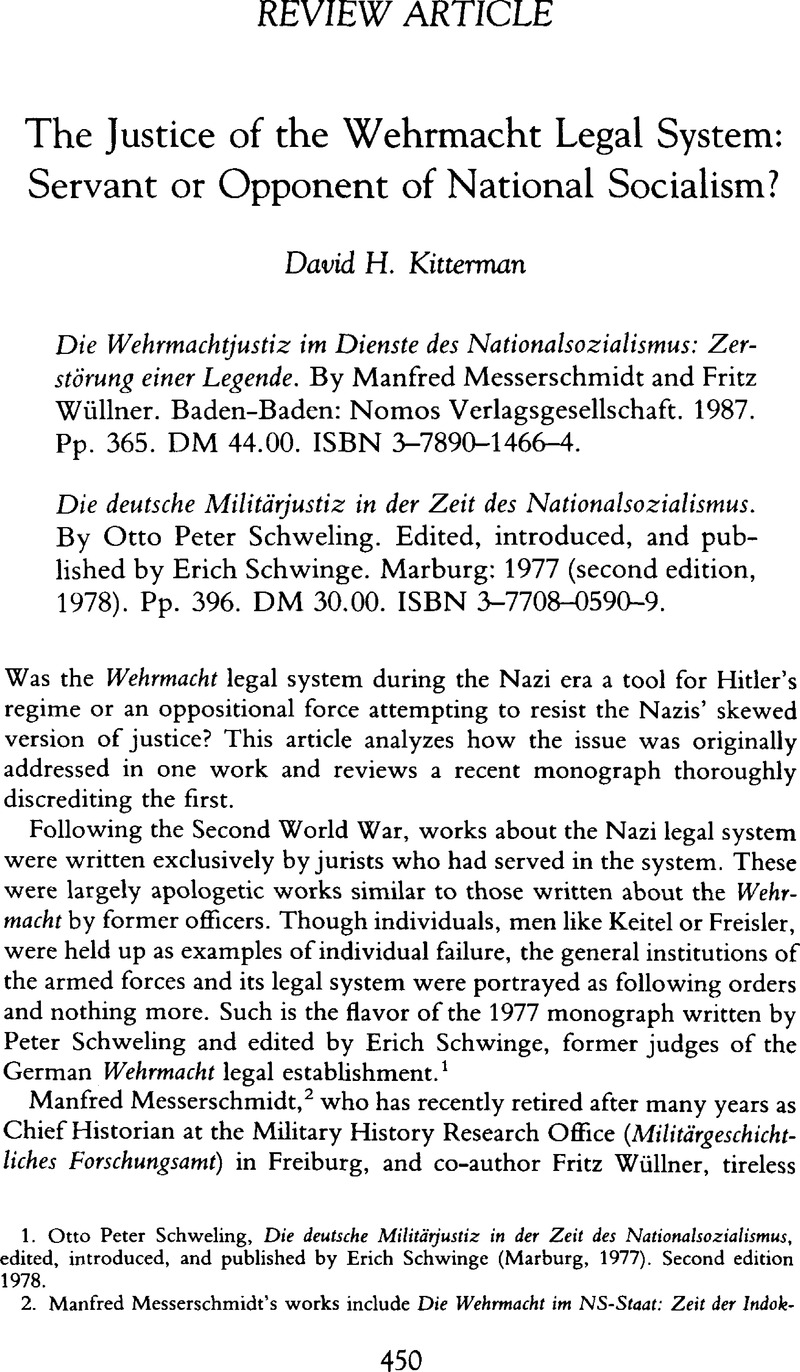No CrossRef data available.
Article contents
The Justice of the Wehrmacht Legal System: Servant or Opponent of National Socialism?
Published online by Cambridge University Press: 16 December 2008
Abstract

- Type
- Review Articles
- Information
- Copyright
- Copyright © Conference Group for Central European History of the American Historical Association 1991
References
1. Schweling, Otto Peter, Die deutsche Militärjustiz in der Zeit des Nationalsozializmus, edited, introduced, and published by Schwinge, Erich (Marburg, 1977). Second edition 1978.Google Scholar
2. Messerschmidt's, Manfred works include Die Wehrmacht im NS-Staat: Zeit der Indoktrination (Hamburg, 1969);Google ScholarPolitische Geschichte der preussischdeutschen Armee (Munich, 1975);Google ScholarMilitär und Politik in der Bismarckzeit und im Wilhelminischen Deutschland (Darmstadt, 1975);Google Scholar“The Wehrmacht and the Volksgemeinschaft,” Journal of Contemporary History 18 (1983): 719–44;Google Scholar“Das Verhälthis von Wehrmacht und NS Staat und die Frage der Traditionsbildung,” Aus Politik und Zeitgeschichte 17 (1981): 11–23Google Scholar; 1, “Die Wehrmacht im NS-Staat,” in Bracher, Karl–Ditrich, ed., Nationalsozialistische Diktatur, 1933–1945: Eine Bilanz (Düsseldort, 1983), 465ff;Google Scholar“Dectsche Militärgerichtsbarkeit im Zweiten Weltkrieg,” in Vogel, H.-J. and others, eds., Die Freiheit des Anderen. Festschrift für Martin Hirsch (Baden-Baden, 1981), 111–42;Google Scholar“German Military Law in the Second World War,” in Deist, W., ed., The German Military in the Age of Tital War (Leamington Spa, 1985), 323–35;Google Scholar he co-authored Offiziere im Bild von Documenten aus drei Jahrhunderten (Stuttgart, 1964);Google ScholarUrsachen und Voraussetzungen der deutschen Kriegspolitik (Stuttgart, 1979);Google Scholar and Militärgeschichte. Probleme—Thesen—Wege (Stuttgart, 1982).Google Scholar
3. Messerschmidt, Manfred and Willner, Fritz, Die Wehrmachtjustiz im Dienste des Nationalsozialismus: Zerstörung einer Legende (Baden-Baden, 1987), 9.Google Scholar
4. Erdmann, Karl Dietrich, “Zeitgeschichte, Militärjustiz, und Völkerrecht: zu einer aktuellen Kontroverse,” Geschichte, Wissenschaft und Unterricht 30, no. 3 (1979): 129–32.Google Scholar
5. See letter of Broszat, Martin in the Frankfurter Allgemeine Zeitung, 30 10 1978.Google Scholar
6. Karl Sack worked in the Military Law branch from 1934 on and, after the “Fritsch crisis” in 1939, waged a constant secret war againts the Gestapo. He also formed a link between Admiral Canaris, leader of the Abwehr, and the man of the Confessing Church. He was muedered in Flossenburg concertration camp by the SS in the last month of the war, on 9 April 1945, together with Dietrich Bonhoeffer and Admiral Canaris. Rüdiger Schleicher was a law professor at Berlin's Humboldt University. Married to the elder Bonhoeffer daughter, he was imprisoned because he had not reported his brother-in-law, who was involved in the 20 July 1944 conspiracy against Hitler. schleicher was murdered without trial or sentence on the night of 23 April 1945 near Moabit prison in Berlin along with his brother-in-law Klaus Bonhoeffer, Professor Albrecht Haushoffer, and many others. See Zeller, Eberhad, The Flame of Freedom: The German Struggle against Hitler (London, 1967), 141–42, 214, 418;Google Scholar and Zimmermann, Erich and Jacobsen, Hans, Germans against Hitler: 07 20, 1944 (Wiesbaden, 1964), 214, 218, 255, 336.Google Scholar
7. Messerschmidt and Wüllner, Wehrmachtjustiz, 11.
8. Information gathered from correspondence of David Kitterman with archivists and history professors from Humboldt University, Berlin and the GDR Military Archives over the past three years. In May and June, 1991, this author worked in the military court martial records of the GDR Military Archives in Potsdam.
9. Messerschmidt and Wüllner, Wehrmachtjustiz, 112–14; compare with Schweling, 281–83.
10. Messerschmidt and Wüllner, Wehrmachtjustiz, 90–91, 132–38.
11. Kitterman, David H., “Those Who Said ‘No!’: Germans Who Refused to Execute Civilians during World War II,” German Studies Review 11 (1988): 241–54CrossRefGoogle Scholar. See especially 246–47. A monograph on this theme is currently in preparation.
12. Messerschmidt and Wüllner, Wehrmachtjustiz, 12, also 310 for similar conclusions.
13. Filbinger, Hans, Die geschmähte Generation (Munich, 1987), 23.Google Scholar
14. Messerschmidt and Wüllner, Wehrmachtjustiz, 13.
15. Messerschmidt, “German Military Law in the Second World War,” 323–24.
16. Messerschmidt, “German Military Law in the Second World War,” 325. He cites the Kriegssonderstrafrechtsverordnung of 17 August 1938, in Reichsgesetzblatt (RGBL) 1 (1939): 1455;Google Scholar Messerschmidt and Wüller, Wehrmachtjustiz, 38.
17. Messerschmidt, “The Wehrmacht and volksgemeinschaft,” 719–44.
18. Erdmann, “Zeitgeschichte,” 131.
19. Messerschmidt and Wüllner, Wehrmachtjustiz, 40–41; Messerschmidt, “German Military Law in the Second World War,” 330; Schweling/Schwling, Die deutsche Militärjustiz, 322.
20. Messerschmidt, “German Military Law in the Second World War,” 326–27.
21. Ibid., 324; Messerschmidt and Wüllner, Wehrmachtjustiz, 29–39, 70.
22. Messerschmidt and Wüllner, Wehrmachtjustiz, see chapter 4, “Die Grössenordnung,” and chapter 5, “Todesurtelie,” in Wehrmachtjustiz, 47–90; Schweling/Schwinge, Die deutsche Militärjustiz, 284–85.
23. Schulte, Theo J., The German Army and Nazi Policies in Occupied Russia (Oxford, 1989), 244;Google ScholarBerghahn, V. R., “NSDAP und geistige Führung der Wehrmacht 1939–1943,” Vierteljahrshefte für Zeitgeschichte 17 (1969): 17–71.Google Scholar
24. Schulte, The German Army, 248–49.
25. Messerschmidt and Wüllner, Wehrmachtjustiz, 212.
26. Ibid., 212–13; Schweling/Schwinge, Die deutsche Militärjustiz, 342f.
27. Messerschmidt and Wüllner, Wehrmachtjustiz, 214.
28. Ibid., 217; Streit, Christian, Keine Kameradan. Die Wehrmacht und die sowjetischen Kriegsgefangenen 1941–1945 (Stuttgart, 1978), 125Google Scholar; another excellent monograph is Streim, Alfred, Die Behandlung sowjetischer Kriegsgefangener im “Fall Barbarossa”. Eine Dokumentation. Unter Berücksichtigung der Unterlagen deutscher Strafvollzugsbehörden und der Materialien der Zentralen stelle der Landesjustizverwaltungen zur Aufklärung von NS–Verbrechen (Heidelberg, 1981).Google Scholar
29. Messerschmidt and Wüllner, Wehrmachtjustiz, 217–23, has a reproduction of the judgment and a full description and analysis of his crime.
30. Messerschmidt and Wüllner, Wehrmachtjustiz, 310.




